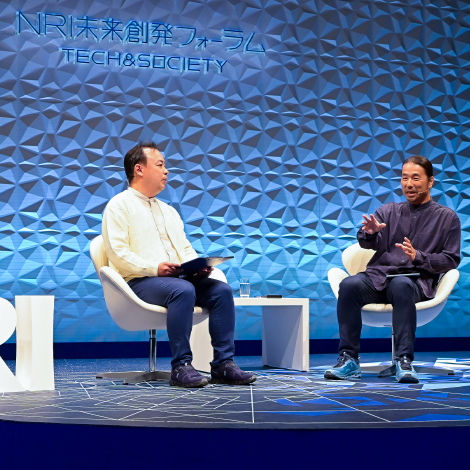Mar. 19, 2024
Lily pads will double in number in a few days’ time. If some lily pads were to appear in a pond one day, you wouldn’t really take notice while there are still so few of them. Even when they’ve covered around half of the pond after a time, you still might not think much of them. Yet, if you take a look after a day or two, you’ll be astonished to see the entire surface of the water covered by lily pads. That’s what’s meant by the phrase “exponential change”—at the initial stage the change is barely noticeable, but when that curve rises vertically the change happens at a staggering speed. The recent astonishing innovations in generative AI are exponential in nature, with dramatic changes occurring on a daily basis.
Singularity approaching more rapidly with generative AI
GPT-1 first hit the world stage in 2018. At the time it had over 100 million parameters, which signify the AI’s performance capabilities, but now GPT-4 which was released this year has over one trillion parameters. The number of parameters is often likened to the number of intra-neuron connections in the brain (synapses), but there are said to be 100 trillion synapses in the human brain (brain scale). Of course, the human brain’s abilities can’t be expressed purely in terms of the number of synapses, but the number of parameters of a generative AI may very well end up surpassing the brain scale of human beings in just a few years.
In 2007, the Japanese translation of Ray Kurzweil’s 2005 book “The Singularity is Near: When Humans Transcend Biology” was published. In it, he predicted that in the mid-2040s, a “singularity” would occur, this being the moment when machines finally transcend human capabilities, but that moment may very well come ahead of schedule. We have already entered the initial stage of the singularity.
Incidentally, what is it that sets generative AI from the AIs that have come before? One thing is its ability to learn unstructured data like images, figures, and sentences. Another is how it’s possible to use natural language to communicate with the AI (meaning that you don’t have to be an expert programmer to handle AI easily). What’s more, it can create natural sentences, images, speech, and the like; to put it plainly, the kinds of creativity once thought to be unique to human beings is now possessed by machines.
Since image generating AIs were first launched, over 1.5 billion images have been created in just the past year. Instructions called prompts have been exchanged with AIs over thousands of hours, leading to the creation of spectacularly detailed paintings and photographs, and there have even been instances of painting and photography contests where the content created by the generative AI has won. Some would say that since the AI has trained on past images, these aren’t actually true creations, but human beings also engage in creative activities based on past experience and such, and so it’s unreasonable to suggest that the products of generative AI uniquely lack creativity. It can be said that generative AIs are producing abundantly creative products.
In addition, one feature of generative AI is how good it is at imitating human speech and behavior. For instance, the Sydney Jewish Museum features an exhibition that involved conducting interviews over many hours with Holocaust survivors, and then having AI learn from those recordings to provide an interactive experience where visitors can ask questions and get answers in a “conversation” with digital versions of those survivors. In China, it made the news when an average blogger used speech synthesis to create an avatar of his beloved deceased grandmother and converse with her. In any of these cases, the use of generative AI makes it possible to transcend time and space and “warp” back to the past. If you were to archive your own voice now, your future descendants could speak with you anytime.
Generative AI and Japan’s challenge
Generative AI is also transforming our corporate system. Generative AI is being deployed not just for automatically creating programs, but also for tasks that previously were handled only by human beings, such as information collection and analysis, strategic planning, creative work, or even customer service and call center operations. Ultimately this has led to growing concerns that human jobs will be taken over by AI, and in the U.S., we saw Hollywood writers go on strike over this.
Eight years ago, we published the prediction results from a joint study conducted by NRI and Oxford University Associate Professor Michael Osbourne, which found that 49% of Japan’s labor force could be replaced by AI and robots within 20 years. However, I don’t believe that AI is necessarily taking away people’s jobs. Rather, I would venture that AI is likely supporting human beings, with the two working together in a way that elevates the quality of business operations and services.
Nearly all of the generative AI platforms out there were created in the U.S., and going forward, platform development—which requires tremendous capital and human resources—will probably continue to be dominated by U.S. companies. On the other hand, according to a survey questionnaire given by Adobe, Japan was cited as the most creative country in the world, followed by the U.S. and France. In addition, Tokyo took the top spot among the most creative cities, followed by New York and Paris. Japan also had the most winners at Kaggle’s global competition for data scientists, followed by China, the U.S., and India. In other words, in terms of the number of top engineers leveraging their creativity and AI, Japan is at the forefront globally.
The real competition in the field of applications using AI platforms is yet to come, and Japan stands a chance at being the victor in that as well.







